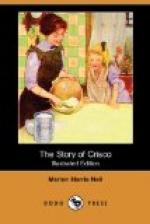To Clarify
It is economy to use three pounds in the kettle, clarifying the fat when it is put away. To clarify Crisco, take that which has been used for deep frying and when it has cooled, but not solidified, strain through a double thickness of cheese cloth, replace kettle on stove, drop several slices of potato into the Crisco and reheat. When the potatoes are golden brown, take out and pour the Crisco back into the tin. With this little care, fish, oysters, onions, chops, fritters, doughnuts, etc., may be fried over and over again in the same Crisco.
[Illustration]
The dry or saute method of frying is less satisfactory, in that it is difficult even after much practice to produce a uniformly colored surface. A small quantity of fat only is needed, and where the fat, i.e., the heat, ends, a crack is formed in the outer coat, through which flavor escapes and fat enters; the appearance also is rendered unsightly. Flat fish can be fried fairly well by this method, or, indeed, almost any thin substance, as thin edges are not affected in this way. For pancakes and other articles of similar nature it is the best method. It rarely is possible to use the fat from the dry method a second time, except for dishes of the same kind, as the fat always is more or less flavored by the food cooked in it. The most digestible fat for frying and the best for results undoubtedly is Crisco.
Steaming
Steaming is a process very similar to boiling, for it is cooking in the heated vapor of water. This practice as a means of cookery is largely adopted in hotels, clubs, schools and hospitals, and other large institutions; also frequently applied in ordinary home cookery for particular articles of food requiring a very slow process of cooking. An ordinary kitchen steamer, with a close-fitting lid is generally all that is required for simple household cookery on a small scale. The articles of food which are to be steamed are prepared in exactly the same manner as for boiling. Many puddings, some meats, and some vegetables are considered better if cooked by steam, and inasmuch as the process of cooking is a very slow one, there is no fear of the food being destroyed by too fierce a heat, as the temperature in steaming never reaches beyond 212 deg. F. Fish, meat and poultry cooked by steam are as a rule tender, full of gravy and digestible. By steaming, watery vegetables are made drier; tough meats are softened and made tender; while farinaceous mixtures and puddings develop a totally different flavor when baked or fried.




